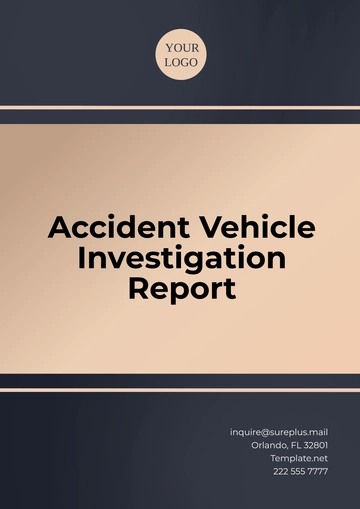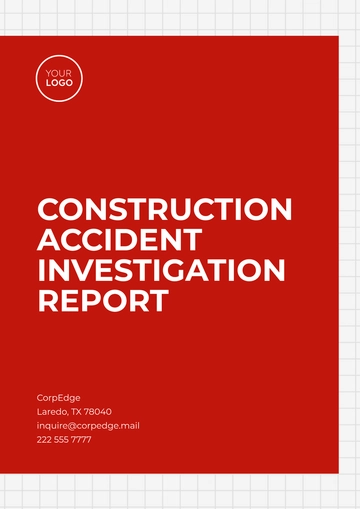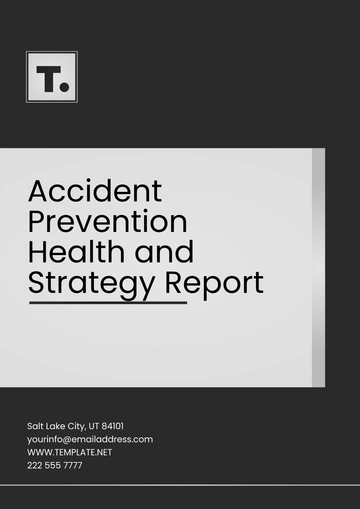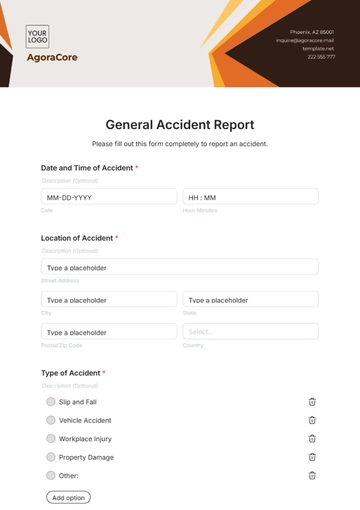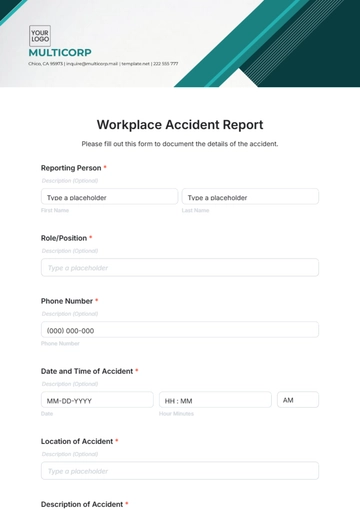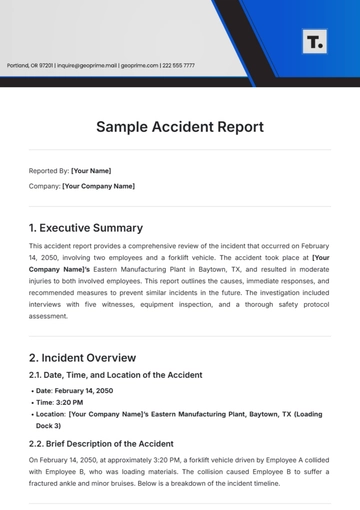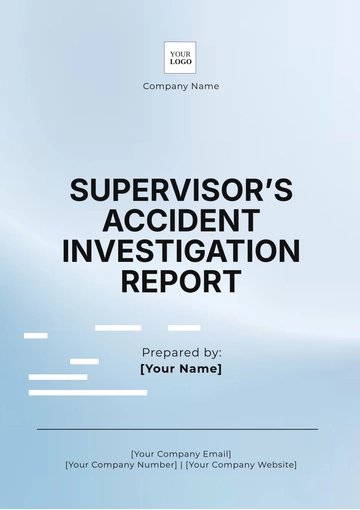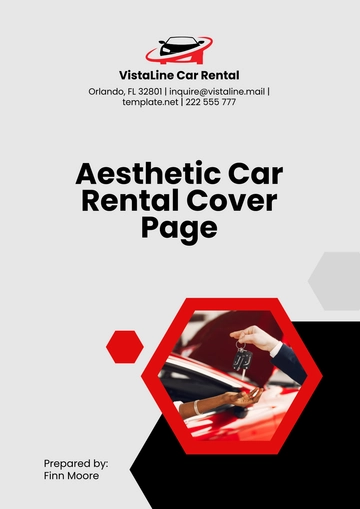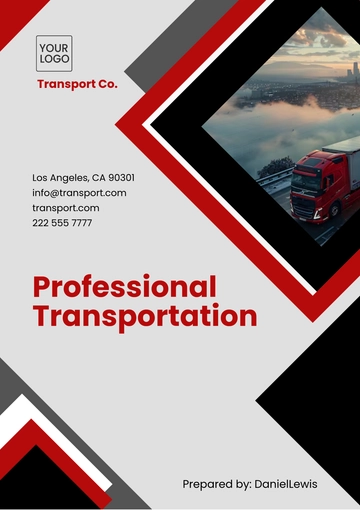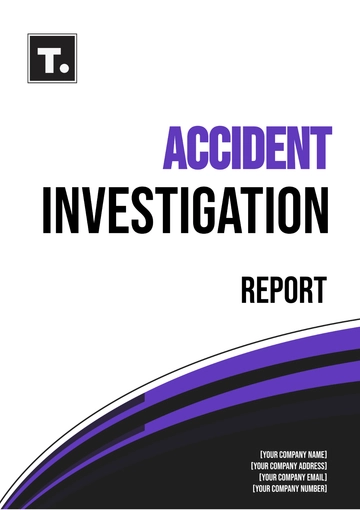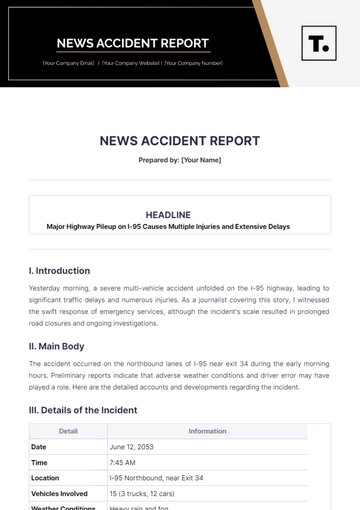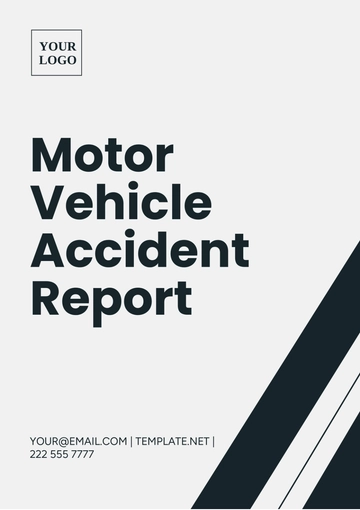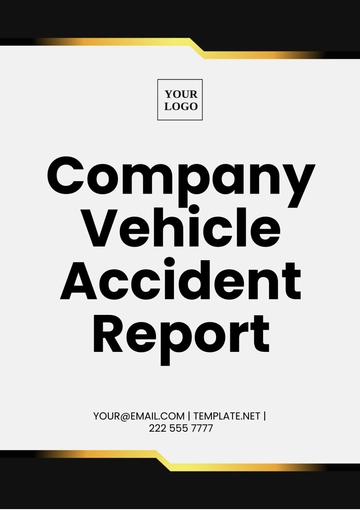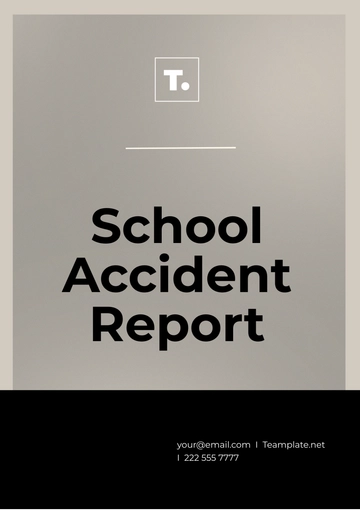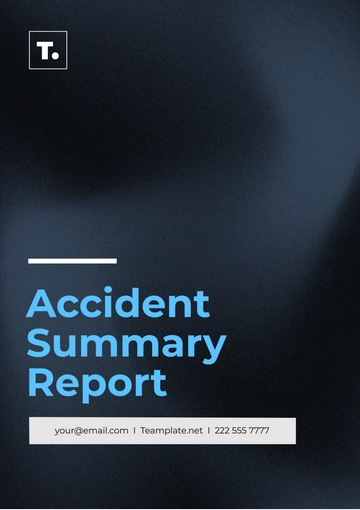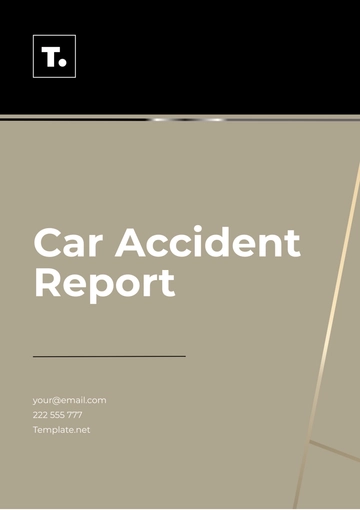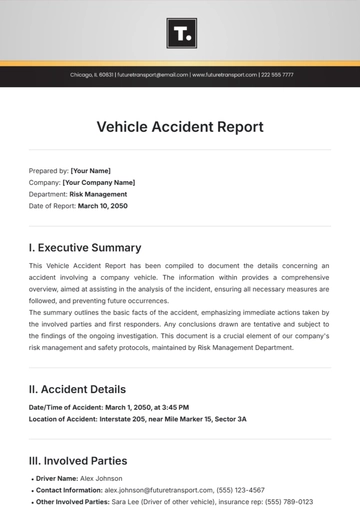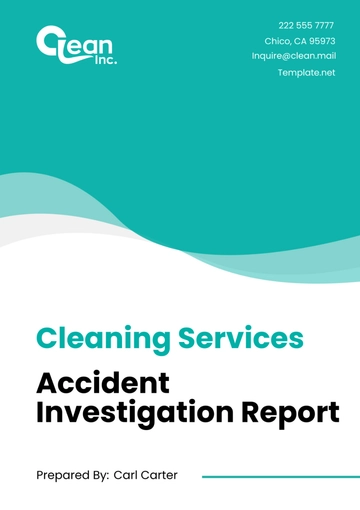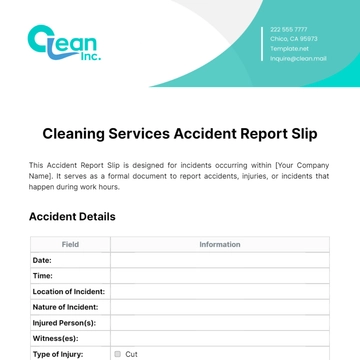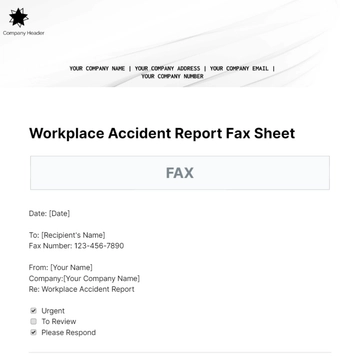Free Transport Accident Report
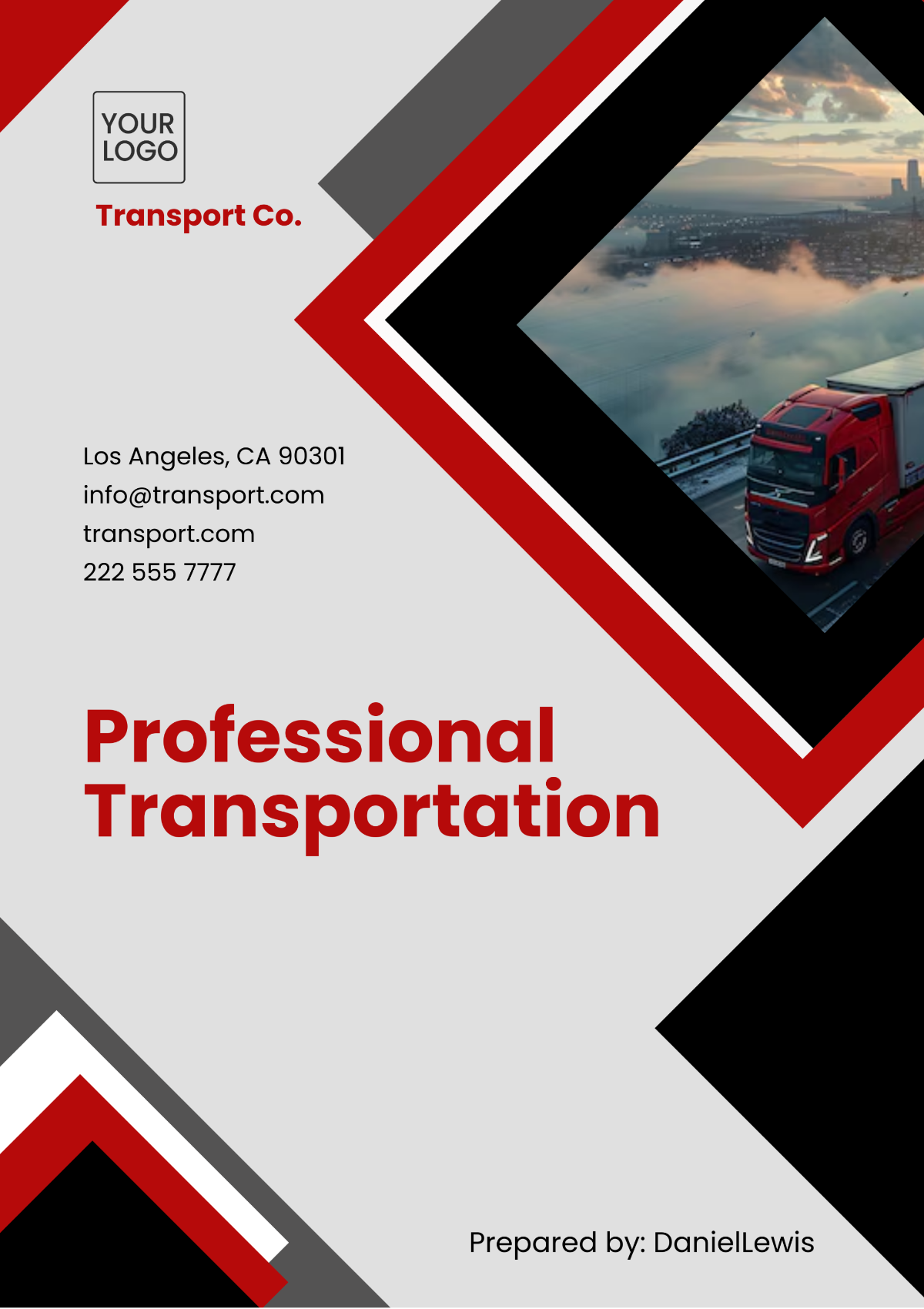
Incident Date: January 12, 2050
Report Submission Date: January 13, 2050
Report Reference Number: TAR-2050-001
Company: [Your Company Name]
Report Prepared By: [Your Name], Transport Safety Officer
I. Executive Summary
This comprehensive report provides a detailed analysis of a transport accident involving a [Your Company Name] cargo truck that occurred on January 12, 2050. The accident took place on Route A45 and resulted in considerable vehicle damage, temporary disruption to transportation schedules, and minor injuries to the driver. Key contributing factors to the incident include adverse weather conditions, a malfunctioning autonomous driving system, and ongoing road construction. The total financial impact of the accident is estimated to be [20,000] credits, with the operational downtime estimated at [15] hours. This report aims to identify the primary causes, assess the consequences, and propose measures to mitigate future risks.
II. Incident Description
A. Date and Location
Incident Date:
The accident occurred on January 12, 2050, at approximately [14:30] hours.Location:
Route: The incident happened on Route A45, approximately [8] kilometers from Junction 12. This section of Route A45 is prone to heavy traffic and frequent construction work.
Coordinates: Latitude [34.0522], Longitude [-118.2437]
Landmarks: The accident site is located near a major intersection and adjacent to a residential area with ongoing road improvements.
Environmental Conditions:
Weather: The weather at the time of the incident was characterized by heavy rainfall and gusty winds. Rainfall intensity was recorded at [10] mm/hour, and wind speeds reached [30] km/h. Visibility was reduced to approximately [50] meters.
Road Conditions: The road was wet and slippery, with patches of standing water. Road markings were partially obscured due to the rain, making lane discipline challenging.
B. Vehicles Involved
Vehicle 1 - [Your Company Name] Cargo Truck:
Model: TX-7500
License Plate: [CYT-457]
Driver: Samuel Rodriguez
Cargo: [10,000] kilograms of electronic equipment, including sensitive electronic devices
Speed at Time of Impact: [45] km/h
Condition: The truck suffered extensive damage to the front end, including the engine compartment, radiator, and bumper. The vehicle was rendered inoperable.
Vehicle 2 - Private Passenger Vehicle:
Model: EcoCar ZX 2050
License Plate: [ZWR-1023]
Driver: Emily Thompson
Passengers: None
Damage: The rear bumper was dented, and the taillights were broken. The vehicle sustained minor structural damage but remained operational after the incident.
III. Sequence of Events
A. Pre-Incident
Driver Activity:
Pre-Departure Checks: Samuel Rodriguez performed the standard pre-departure checks at [13:00] hours. This included checking tire pressure, cargo security, and fuel levels. The truck's autonomous system was activated as part of the standard operating procedure.
Communication: Rodriguez communicated with the logistics center, reporting that all systems were functioning normally and that there were no immediate concerns about the route or weather conditions.
Autonomous System Malfunction:
System Failure: At approximately [14:25], the truck’s onboard diagnostic system detected a malfunction in one of the critical sensors, leading to the deactivation of the autonomous driving mode. Rodriguez received an alert indicating the need to take manual control.
Driver Response: Rodriguez attempted to take over manual control of the vehicle, but due to the severe weather and reduced road traction, he struggled to maintain control.
Environmental Impact:
Rain and Visibility: The intensity of the rain increased rapidly, leading to reduced visibility. The wet road conditions caused the truck to hydroplane, making it difficult for Rodriguez to stop or steer effectively.
Wind Effects: The strong winds affected the stability of the vehicle, exacerbating the difficulty in maintaining lane discipline and control.
B. The Collision
Initial Impact:
Collision Timing: At approximately [14:30], the cargo truck skidded on the wet road surface and collided with the rear of the EcoCar ZX 2050, which was traveling at approximately [30] km/h. The impact was significant but not severe enough to cause a rollover.
Impact Force: The collision force was calculated to be approximately [10,000] newtons, based on the relative speeds and the mass of the vehicles involved.
Secondary Incident:
Post-Collision Movement: After the initial impact, the cargo truck veered into a construction barrier, which prevented further movement. The truck came to a complete stop, and no additional vehicles or construction workers were involved in the incident.
IV. Analysis
A. Contributing Factors
Weather Conditions:
Rainfall and Hydroplaning: The intense rainfall significantly reduced road traction, leading to hydroplaning. The truck’s tires were unable to maintain sufficient contact with the road, causing the vehicle to skid uncontrollably.
Visibility Issues: Reduced visibility due to heavy rain contributed to the driver’s inability to detect and react to sudden changes in traffic conditions in time.
Autonomous System Failure:
Sensor Malfunction: The malfunctioning sensor in the truck's autonomous system led to the system’s abrupt disengagement. This failure required the driver to switch to manual control at a critical moment, increasing the risk of an accident.
System Design Review: A preliminary review suggests that the autonomous system may require improved redundancy and fault tolerance to handle unexpected failures more gracefully.
Road Construction:
Lane Closures: The ongoing road construction narrowed the lanes and reduced the available space for maneuvering. The sudden reduction in lane width and traffic slowdown added to the complexity of the driving conditions.
Signage and Warnings: The effectiveness of warning signs and barriers was inadequate in alerting drivers to the extent of the roadwork. Improved signage and clearer indications of lane closures could enhance driver awareness.
B. Mechanical Issues
Brake Performance:
Brake System Check: An inspection of the truck's braking system revealed no mechanical failures. However, the effectiveness of the brakes was significantly reduced due to the wet conditions.
Maintenance Recommendations: Regular brake inspections and maintenance are essential, particularly before operating in adverse weather conditions. Brake performance should be tested in various conditions to ensure reliability.
Tire Condition:
Tire Inspection: The truck’s tires, with [40]% tread depth, were found to be within acceptable limits but were less effective on wet surfaces.
Tire Replacement: Tires should be replaced when tread depth approaches [50]%. Additional precautions should be taken during rainy weather, including reduced speed and increased following distance.
C. Collision Analysis
Impact Analysis:
Damage Assessment: The collision caused extensive damage to the front end of the cargo truck and minor damage to the rear of the passenger vehicle. The impact analysis showed that the damage was consistent with the relative speeds and the point of collision.
Impact Force Calculation: The collision force was estimated using vehicle mass and impact speed, which provides insights into the severity of the impact and the effectiveness of the vehicle’s safety features.
Safety Features:
Airbag Deployment: The cargo truck’s airbag system deployed as intended, mitigating the impact on the driver. The EcoCar ZX 2050’s rear bumper absorbed the impact, preventing more severe damage.
V. Injuries and Casualties
A. Driver Injuries
Driver of [Your Company Name] Truck:
Injuries: Samuel Rodriguez sustained minor injuries, including bruising and mild whiplash. The severity of the injuries was assessed as minor, and Rodriguez was treated at the scene and transported to City General Hospital for further evaluation.
Medical Report: Rodriguez's medical report indicates that he experienced minor musculoskeletal injuries but no fractures or internal injuries. He was advised to rest and undergo physical therapy as needed.
Recovery and Follow-Up:
Return to Work: Rodriguez is expected to return to work within [7] days, following a period of rest and physical therapy. His return will be subject to a final medical clearance.
Counseling Services: [Your Company Name] has offered counseling services to address any potential psychological impacts resulting from the accident.
B. Other Parties Involved
Driver of EcoCar ZX 2050:
Injuries: Emily Thompson reported feeling shaken but did not sustain physical injuries. She declined medical treatment at the scene but was advised to consult a physician if symptoms developed.
Post-Incident Care: Thompson was offered support services by [Your Company Name] and has been provided with information on seeking medical attention if needed.
C. Fatalities
Fatality Report:
Incident Outcome: No fatalities occurred as a result of the accident. The presence of functioning safety features, such as seatbelts and airbags, played a crucial role in preventing more severe outcomes.
VI. Damages and Losses
A. Vehicle Damage
[Your Company Name] Cargo Truck:
Component | Damage Description | Estimated Repair Cost |
|---|---|---|
Front Bumper | Crumpled and detached | [3,000] credits |
Engine Block | Severe damage, leaking coolant | [6,000] credits |
Radiator | Cracked and inoperable | [2,500] credits |
Headlights | Shattered and non-functional | [1,500] credits |
Total Repair Cost | [13,000] credits |
EcoCar ZX 2050:
Component | Damage Description | Estimated Repair Cost |
|---|---|---|
Rear Bumper | Dented and scratched | [1,500] credits |
Taillights | Broken and non-functional | [1,000] credits |
Total Repair Cost | [2,500] credits |
B. Cargo Damage
Electronics Cargo:
Item | Quantity | Damage Description | Estimated Loss Cost |
|---|---|---|---|
Laptops | [500] units | Screen damage, functional issues | [2,000] credits |
Servers | [200] units | Physical damage, operational failures | [1,000] credits |
Accessories | [1,000] units | Packaging damage, minor functional issues | [500] credits |
Total Loss Cost | [3,000] credits |
C. Indirect Losses
Operational Downtime:
Aspect | Description | Estimated Downtime Cost |
|---|---|---|
Fleet Operations | Disruption of [15] hours | [10,000] credits |
Delivery Delays | Average delay of [6] hours per delivery | [5,000] credits |
Total Downtime Cost | [15,000] credits |
Client Compensation:
Client | Compensation Provided | Total Compensation Cost |
|---|---|---|
Client A | [5%] discount on future services | [300] credits |
Client B | [5%] discount on future services | [200] credits |
Total Compensation Cost | [500] credits |
VII. Preventative Measures
A. Autonomous System Improvements
System Diagnostics and Upgrades:
Diagnostic Procedures: Regular and rigorous diagnostic procedures will be implemented to detect potential sensor malfunctions before they affect vehicle performance.
System Redundancy: Additional redundancy and fault tolerance will be incorporated into the autonomous system to handle sensor failures more effectively.
Software Updates: Frequent software updates will be conducted to ensure the system is equipped with the latest safety features and improvements.
Driver Training Enhancements:
Training Modules: Comprehensive training modules will be developed to enhance driver skills in transitioning between autonomous and manual control.
Adverse Weather Training: Special training sessions will focus on handling adverse weather conditions, including practical exercises and simulations.
B. Weather-Related Policies
Weather Alert System:
Implementation: A real-time weather alert system will be installed in all vehicles to provide drivers with up-to-date information on weather conditions along their route.
Route Adjustments: Drivers will be instructed to adjust their routes or delay travel based on severe weather alerts to ensure safety.
Tire Maintenance and Replacement:
Inspection Schedule: An increased tire inspection schedule will be implemented to monitor tread depth and overall tire condition.
Replacement Policy: Tires will be replaced proactively when tread depth reaches [50]%, and additional precautions will be taken in wet conditions.
C. Road Construction Coordination
Collaboration with Authorities:
Advance Notice: [Your Company Name] will collaborate with local transportation authorities to receive advance notice of road construction and closures.
Driver Notifications: Enhanced notifications will be provided to drivers about roadworks, including detailed maps and updated route options.
Signage and Warning Improvements:
Signage Review: A review of existing signage will be conducted to ensure clarity and visibility.
Advanced Warnings: Improved advanced warning systems will be implemented to alert drivers well ahead of construction zones.
VIII. Conclusion
This report has meticulously detailed the events and circumstances surrounding the transport accident on Route A45 on January 12, 2050. The analysis has identified several contributing factors, including severe weather conditions, a malfunctioning autonomous system, and ongoing road construction. While the incident resulted in vehicle damage, cargo loss, and operational disruptions, the impact was mitigated by the timely deployment of safety features.
Recommendations have been provided to address the identified issues, including improvements to the autonomous driving system, enhanced driver training, and better coordination with road construction authorities. The implementation of these measures will be crucial in preventing similar incidents in the future and ensuring the continued safety of [Your Company Name]'s fleet and operations.
- 100% Customizable, free editor
- Access 1 Million+ Templates, photo’s & graphics
- Download or share as a template
- Click and replace photos, graphics, text, backgrounds
- Resize, crop, AI write & more
- Access advanced editor
Document incidents effectively with the Transport Accident Report Template from Template.net. This editable and customizable template provides a structured format for detailing accidents. Customize the report easily in our Ai Editor Tool to ensure thorough and accurate documentation.
You may also like
- Sales Report
- Daily Report
- Project Report
- Business Report
- Weekly Report
- Incident Report
- Annual Report
- Report Layout
- Report Design
- Progress Report
- Marketing Report
- Company Report
- Monthly Report
- Audit Report
- Status Report
- School Report
- Reports Hr
- Management Report
- Project Status Report
- Handover Report
- Health And Safety Report
- Restaurant Report
- Construction Report
- Research Report
- Evaluation Report
- Investigation Report
- Employee Report
- Advertising Report
- Weekly Status Report
- Project Management Report
- Finance Report
- Service Report
- Technical Report
- Meeting Report
- Quarterly Report
- Inspection Report
- Medical Report
- Test Report
- Summary Report
- Inventory Report
- Valuation Report
- Operations Report
- Payroll Report
- Training Report
- Job Report
- Case Report
- Performance Report
- Board Report
- Internal Audit Report
- Student Report
- Monthly Management Report
- Small Business Report
- Accident Report
- Call Center Report
- Activity Report
- IT and Software Report
- Internship Report
- Visit Report
- Product Report
- Book Report
- Property Report
- Recruitment Report
- University Report
- Event Report
- SEO Report
- Conference Report
- Narrative Report
- Nursing Home Report
- Preschool Report
- Call Report
- Customer Report
- Employee Incident Report
- Accomplishment Report
- Social Media Report
- Work From Home Report
- Security Report
- Damage Report
- Quality Report
- Internal Report
- Nurse Report
- Real Estate Report
- Hotel Report
- Equipment Report
- Credit Report
- Field Report
- Non Profit Report
- Maintenance Report
- News Report
- Survey Report
- Executive Report
- Law Firm Report
- Advertising Agency Report
- Interior Design Report
- Travel Agency Report
- Stock Report
- Salon Report
- Bug Report
- Workplace Report
- Action Report
- Investor Report
- Cleaning Services Report
- Consulting Report
- Freelancer Report
- Site Visit Report
- Trip Report
- Classroom Observation Report
- Vehicle Report
- Final Report
- Software Report
